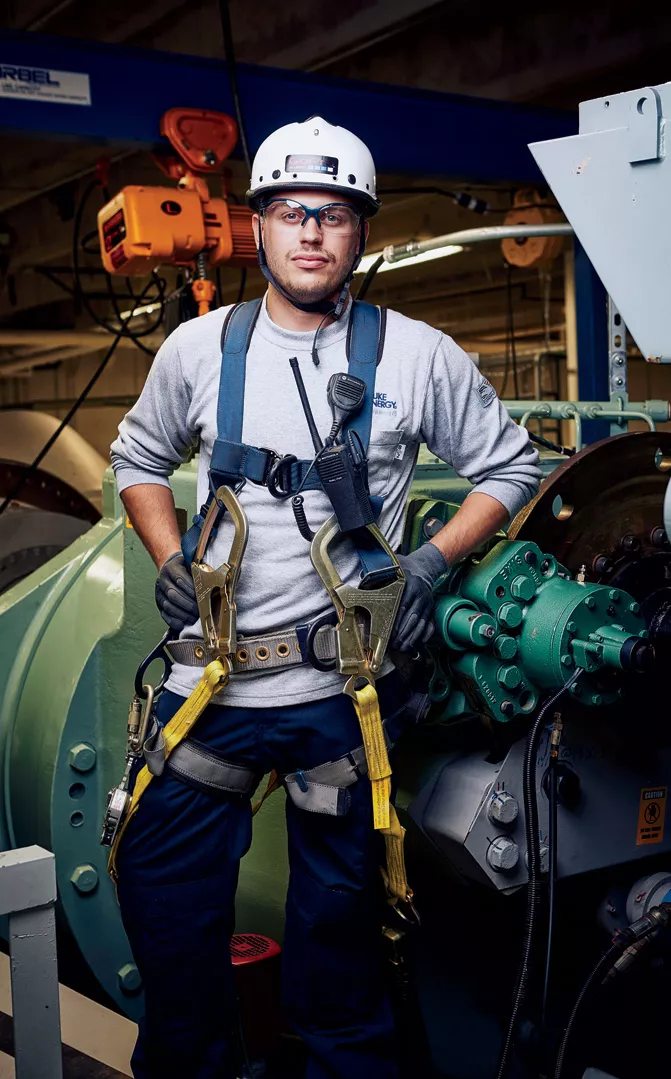A Green Job with a View
Every day, the clean energy revolution is creating new jobs for American workers. As part of an ongoing series, "Sierra" asked one of them to tell us his story.

Mark Honstein, a wind turbine technician in Cheyenne, Wyoming. | Photo by Willie Petersen
Adapted from an interview with Mark Honstein by Reed McManus.
I service wind turbines, performing annual and semiannual service cycles. I basically keep the turbines greased and running and all that good stuff. I also do preventive maintenance—taking care of anything that could wear out over time, like bearings. We don't want parts breaking and causing downtime when the turbines can't produce energy.
I've been working for Duke Energy in Cheyenne for six months, at its Happy Jack and Silver Sage wind farms, which have 34 turbines and generate 71 megawatts of electricity.
On a typical day, our team starts at 6 a.m. We have a morning briefing and go over a plan of attack for the day. We go through warm-up exercises and do stretches, just to make sure everyone is limbered up. It's fun. We put music on. It helps prevent injuries on the job. On a normal shift, I'm up in the air for seven or seven and a half hours. The towers are 280 feet high. The view is beautiful up there. We carry our phones up-tower. You don't want to be hanging off the side with your phone, or you could drop it, but there are opportunities to get photos, as long as you're doing it safely.
Before I started working for Duke, I was a traveling wind technician. I'd go to Michigan, Texas, and California and see a lot of different sights. The site outside of Bad Axe, on Michigan's "thumb," was probably the prettiest, because we were there in the fall and the trees were changing. There are always good views in California's Tehachapi Pass, too. Here in Wyoming, it's a bit flatter, so we don't get as great a view. But I like coming home to the same bed every night. It's much nicer than living out of a hotel room.
I want to work up to senior wind technician and run all the daily operations at a site. It would mean I'd spend a little more time on the ground than up in the air, doing the paperwork, making sure things were getting done.
My job is physically strenuous, so it pays more than a lot of jobs in the area—definitely more than McDonald's. Once you've gone through a wind turbine training program, you get paid more than someone hired without experience.
I enrolled in the wind-energy technology program at Laramie County Community College because I think it's important for the country to have a diverse energy system. I wanted to do my part. It's a two-year program. You learn everything about how turbines work—how to read hydraulic schematics and wiring diagrams, how the energy grid works in our country and how the wind turbines tie into that. You also learn climbing safety. In this field, it's important to get good training. It's dangerous, and there's a lot of information. The college's instructor has been in the industry for 11-plus years, and even he is still learning new things.
Nothing dangerous has happened to me so far, but there is always the potential for trips and falls. Our climbing harnesses will catch us if we fall and prevent us from getting seriously injured. My friends think that what I do is exciting. I don't think that all of them would want to do it, though. A couple of them are afraid of heights.
Every semester, I go out and talk to the new students in the program. It's important. At one point, I was one of them. It helps them to meet someone who's been through the program and has been out in the field for a while. I tell them to take it all step-by-step—that there's a lot to learn and take in, that even I felt overwhelmed when I started the program. That it's a cool job, and challenging. You always want to learn more, to advance your career and to keep everyone around you safe. I try not to scare 'em away. But I explain that the more they know, the safer it'll be for everyone.
Wind will always have skeptics who think turbines are eyesores or whatever. But in my experience, when people actually see what wind is about and the jobs it produces, they accept it.
I love learning how the turbines work and being able to fix them. It brings a lot of joy to me at the end of the day when a turbine has been down for some reason and we're able to fix it, finally see it fire up again, and produce energy.
This article appeared as "Up in the Air" in the January/February 2016 print edition of Sierra.
This article was funded by the Sierra Club's Beyond Coal campaign.
 The Magazine of The Sierra Club
The Magazine of The Sierra Club



